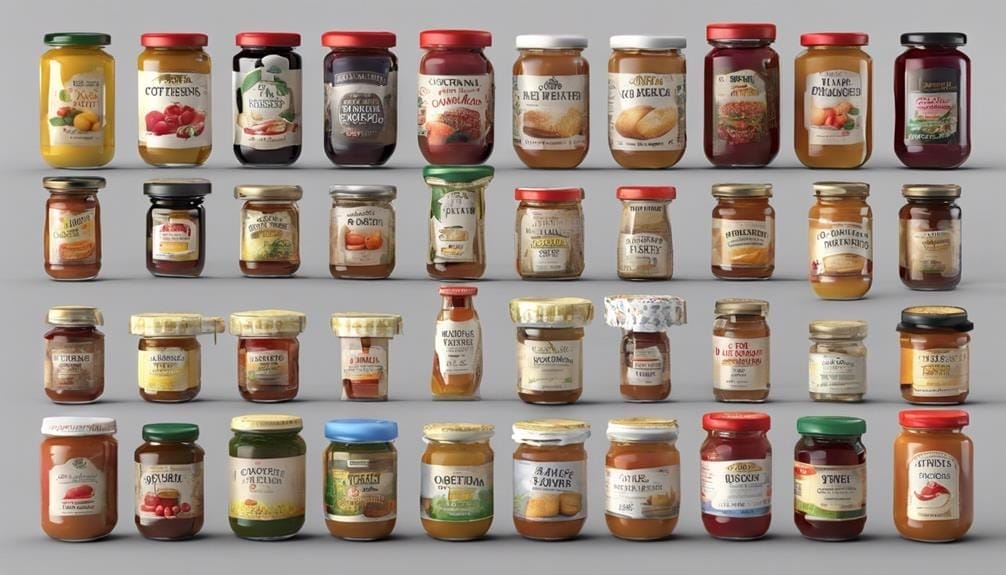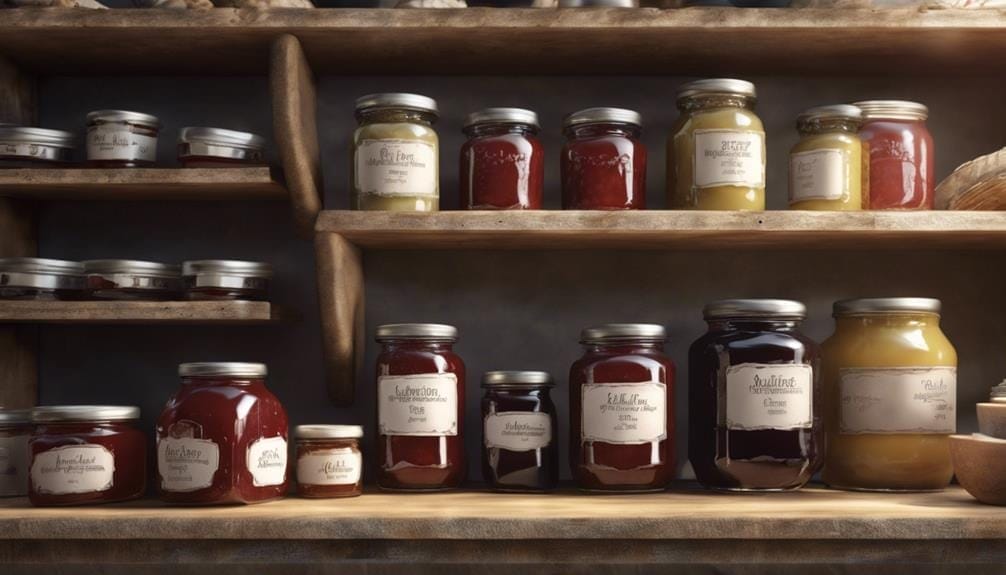When labeling your cottage food, make sure to include your home kitchen address, the food's name, allergens used, and a disclaimer. Use clear and descriptive product names for branding. List ingredients and allergens for transparency and consumer safety. Display net weight for pricing accuracy and compliance. Follow state guidelines for proper labeling. Remember, clear labels build trust and help your baked goods stand out on the market. Stay tuned to uncover more crucial tips for effectively pricing your home-baked goods.
Labeling Requirements Overview
Understanding the labeling requirements for cottage foods is important for ensuring compliance and informing consumers about the products they're purchasing.
When labeling your cottage food products, make sure to include the name and physical address of your home kitchen where the food was produced. Moreover, it's critical to clearly state the common or usual name of the food product on the label.
Remember to disclose any major allergens used in the food to alert consumers with allergies. One necessary statement that must be included on your cottage food labels is 'This food is made in a home kitchen and isn't inspected'. This disclaimer ensures transparency and sets proper expectations for consumers.
Product Name
When labeling your cottage food products, you must make sure that the product name is clear, descriptive, and easily identifiable. The product name plays an important role in branding and market appeal, helping customers recognize and differentiate your products.
Whether you opt for a branded name that reflects your unique offerings or a generic name that straightforwardly describes the product, make sure it improves recognition and builds customer engagement. A well-chosen product name not only aids in marketing but also assists in setting your products apart from competitors.
Ingredients List

Make sure that your cottage food labels prominently display a detailed list of all ingredients utilized in your product. When listing ingredients, keep in mind that they should be arranged in descending order of predominance by weight. This means that the most significant ingredient comes at the top, followed by the others in decreasing order of importance.
If your product contains sub-ingredients that contribute to its composition, these should also be included in the list. It's important to adhere to your state-specific guidelines when detailing ingredients on your cottage food labels.
Using thermal label printers is recommended to make sure that your ingredient list is detailed and legible for your customers. By following these guidelines and creating a clear and detailed ingredients list, you can provide transparency and valuable information to consumers about what goes into your homemade goods.
Allergen Information
Make sure that your cottage food labels prominently display detailed information regarding major food allergens present in your products. Ensuring transparency about allergen information on your labels is essential for consumer safety and compliance with regulations.
Here are some key points to keep in mind:
- List Major Food Allergens: Disclose the presence of major allergens like peanuts, tree nuts, milk, eggs, wheat, soy, and fish on your cottage food labels.
- Inform Consumers: Accurately listing allergens helps individuals with allergies or dietary restrictions make well-informed decisions when purchasing your products.
- Improve Transparency: Providing clear allergen information not only builds trust with your customers but also helps them avoid potential health risks associated with consuming foods they're allergic to.
Net Weight

Clear indication of the net weight on your cottage food labels is vital for informing customers about the quantity of the product they are purchasing. Adhering to labeling requirements and accurately displaying the net weight helps customers understand the portion size and guarantees pricing accuracy. When determining how to present the net weight on your cottage food labels, it is important to follow weights and measures guidelines specific to your state. Different product sizes may require variations in how net weight is indicated. Below is a table exemplifying the importance of net weight on cottage food labels.
| Importance of Net Weight on Cottage Food Labels |
|---|
| Informs customers about quantity purchased |
| Helps with portion size and pricing accuracy |
| Adheres to weights and measures guidelines |
| Variations in net weight display may be needed |
Business Information
Include the name and physical address of your cottage food production operation on the labels to comply with regulations and provide essential business information to customers.
When creating your labels, make sure to:
- Clearly state the common or usual name of the product to help customers identify it easily.
- Disclose all major food allergens used in the food to guarantee the safety of individuals with allergies.
- Include a statement indicating that the food is made in a home kitchen and not inspected by health departments to inform consumers about the production environment.
Production Date

Including the production date on cottage food labels is essential for informing consumers about the freshness and quality of the product. This small but important detail helps customers track the shelf life of the item they're purchasing, ensuring transparency and compliance with food safety guidelines.
By having the production date visible, consumers can make informed decisions about when to consume the product, promoting both safety and satisfaction. Not only does the production date contribute to labeling requirements, but it also plays a critical role in maintaining compliance with cottage food laws and regulations.
Compliance With Regulations
Adhering to cottage food labeling regulations is crucial for guaranteeing consumer safety and trust in your products. Compliance with these regulations isn't only a good practice but also a legal requirement.
To make sure you meet the standards, consider the following:
- Ingredient List: Clearly detail all ingredients used in your products to inform consumers and help those with allergies make informed choices.
- Allergens: Highlight allergens such as nuts, dairy, or gluten prominently on your labels to prevent any potential health risks.
- Consumer Safety: By following labeling regulations, you demonstrate your dedication to the safety and well-being of your customers.
Importance of Clear Labeling

Ensuring clear labeling on your cottage food products is vital for providing consumers with necessary information about the product and its ingredients. Your labels must contain an ingredients list to help customers easily identify what they are consuming. Clear labeling not only aids in transparency in food production but also demonstrates your dedication to consumer safety. Compliance with labeling regulations is important to avoid fines or penalties and maintain trust with your customers.
To emphasize the importance of clear labeling, refer to the table below highlighting key aspects:
| Labeling Aspect | Importance | Example |
|---|---|---|
| Ingredients List | Helps consumers identify what they are consuming | Flour, sugar, eggs |
| Compliance with Regulations | Legal requirement to prevent fines or penalties | FDA guidelines followed |
| Major Food Allergens | Vital for safety, clearly listing allergens | Contains peanuts |
| Transparency in Production | Builds trust with customers, shows commitment to quality | Locally sourced ingredients |
Frequently Asked Questions
How Do You Label Homemade Food?
When you label homemade food, make sure to include all necessary information like ingredients, allergens, and net weight. Provide clear storage instructions, expiration date, and nutrition facts. Follow label requirements for transparency and compliance.
What Is the Texas Cottage Food Law?
The Texas Cottage Food Law regulates the state's cottage industry. It sets rules for homemade labeling, food safety, sales, permits, and regulations. Operators must comply with cottage food restrictions, such as limits on sales and the types of foods allowed.
What Is the Cottage Law for Packaging in Texas?
To comply with the Cottage Law for packaging in Texas, make sure your products meet packaging requirements, follow labeling guidelines, include an ingredient list, provide nutritional information, warn about allergens, offer storage instructions, and display an expiration date.
How Much Is a Texas Cottage Food License?
To get a Texas cottage food license, you'll pay around $167 for two years. This fee covers your registration as a producer. Extra costs like training and insurance might apply for legal operation.
Conclusion
To wrap up, proper labeling of cottage food products is crucial to guarantee compliance with regulations and provide valuable information to consumers. By following the required labeling guidelines, you can establish trust with your customers and showcase the quality of your homemade goods.
Remember to clearly display product names, ingredients, allergen information, net weight, business details, and production dates on your labels to meet legal requirements and promote transparency in your cottage food business.